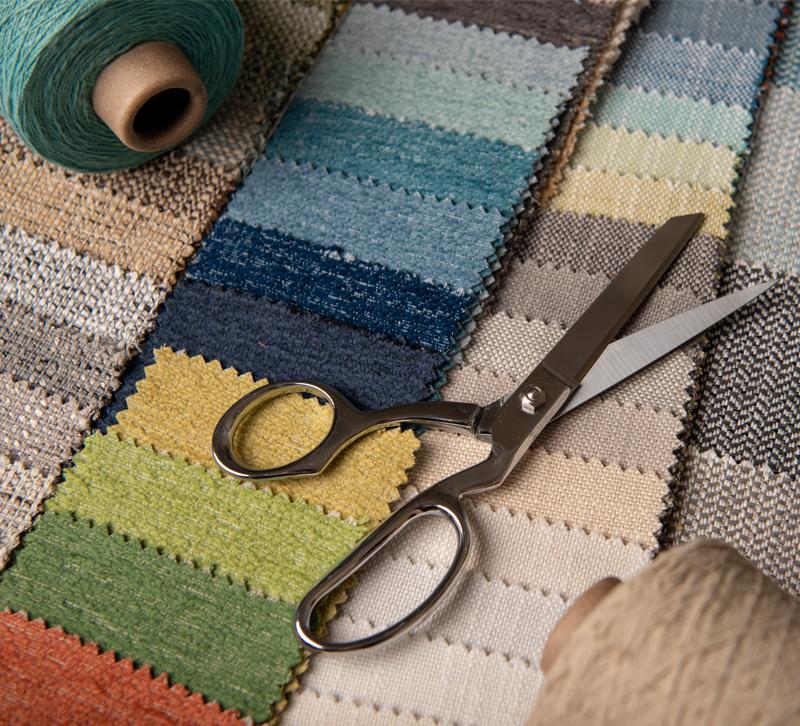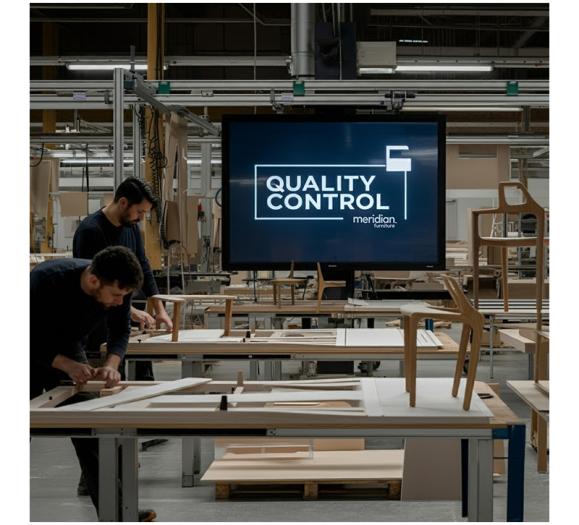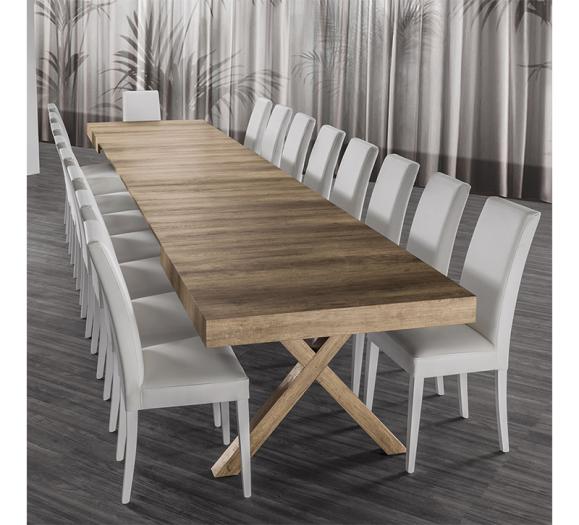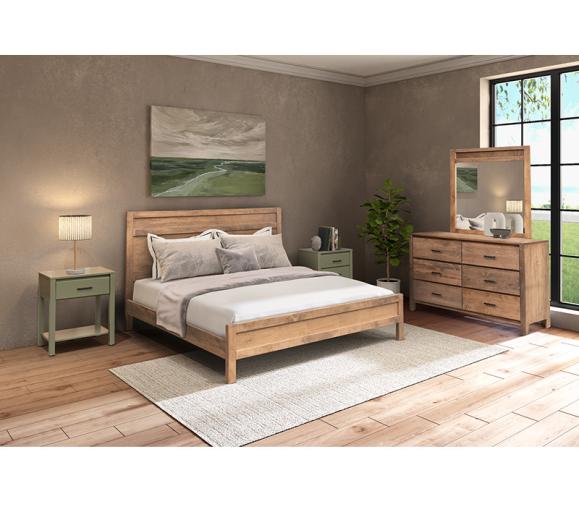If the recent Showtime Fabric Fair was any indication, and it is, the name of the game in upholstered furniture at spring market will be texture, mod patterns, performance and plenty of color.
Trend forecaster Victoria Valentinas, Owner of VLV Designs who was scouting the show on behalf of thehome.com, says “color was number-one” at Showtime this go-round. “One of the big vendors at the fabric fair has a tagline, ‘every color tells a story,’ and I think that would be a good description of the show itself. What stood out was not one particular color (although in talking with vendors and retailers many are saying blue has risen to their number-one), but depth, with multicolored, multi-yarn, mixed, wrapped and spun yarns. Think lots of tricolor in body cloths, even in neutrals like Charcoal and Chocolate with high/low effects.”
Indeed, she says, for every pattern whether solid or accent, “there were a lot of different colorways. I also heard the term ‘whisper of color’ referring to neutrals. Blush, which was the Pantone color of the year not too long ago, and which I think our industry was a little scared of, was everywhere along with Sage. We’re warming up now, moving from the cool grays to warmer canyon colors, all the way from soft, dusty rose blushes into rusts and cognacs, along with more vibrant berries and hot pinks.”
This was particularly true at American Silk Mills where the Argentina Collection drew inspiration from desert landscapes where Italian and Spanish influences contrast with the indigenous people of the Andes. Also at American Silk, Christine Rendino unveiled the next chapter in her luxury textile Sprezzatura collection, expanding her neutral aesthetic with smoky lavender, rose golds and pearl embellishments. “Neutrals are definitely warming up and the smoky lavender is a way of taking the gray trend a little bit warmer,” she says.
Jennifer McConnell, Creative Director of Upholstery at Ambella Home, reported seeing “a lot more reds and corals along with the rusts, as well as a continuation of blues and a lot of teal. Color is becoming a very individual thing,” she says, “with not one color leading the charge. There was an abundance of color, with a whole group of greens out there and yellow coming up.”
Even in leather color was key, which according to designer and product developer Jane Matteson, Principal of Matteson Design and Consulting, is likely an attempt to broaden the market with more feminine appeal. “It’s the same old song. We know who is buying furniture and it’s women,” says the designer, who cut her industry teeth in the luxury home furnishings market at makers like Weiman, Ultrasuede and Swarovski. We know the majority of retail buyers and designers are women. And by and large, the women in our business doing fabric to frame at a more sophisticated level are women. Jennifer McConnell is a perfect example, the kind of talent who can move leather beyond brown and make it sing and make it irresistible.”
Among the looks noted by McConnell, Matteson and Valentinas in leather were an abundance of pretty pastels and shimmering, almost iridescent finishes like the one Kurt Schweizer, President of leather specialist Wipelli, Inc., described as “pixie dust.” It was employed on a nubuck leather called Amalfi. Available in ten colors, the aniline dyed, lustrous leather was velvet-like in its soft, warm hand, and was, Schweizer says, “a very big hit.”
“When you see something unique like that, it really grabs you,” McConnell relates. “Leather has to keep up with fashion in textiles, and it’s becoming so much more exciting than it used to be.”
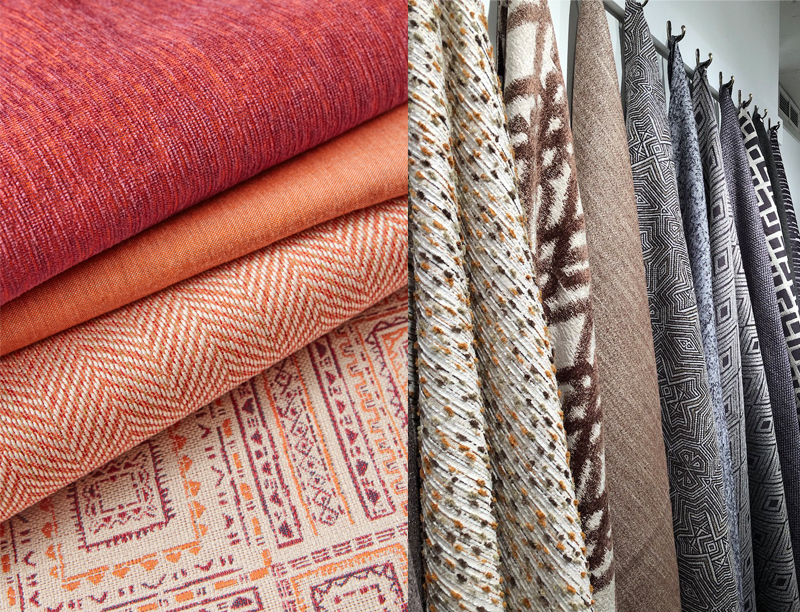
In addition to pastels, Valentinas, who began her career in visual merchandising and upholstery product development at Bassett and later Thomasville, saw “whole walls of vibrant color in leather. I would ask, ‘Are you guys really selling this?’ Because leather is typically brown, gray and black. I think this plays into the texture story, because mixing vibrant colors, pastels or shimmer with texture and different materials like metal or Lucite, particularly in accent chairs, is going to move the category forward.”
Indeed, texture was a key part of the story across the show, and “the chunkier the better,” Valentinas says. “Everything was very high texture. Even in linen, we saw more specialty blends and more of the heavy French Laundry look. There was also a lot of bouclé, especially the classic Chanel tweed look, lots of shearling and velvet was strong again this time as well.”
“People want that matelassé look, the chenille, the bouclé, and velvets continue to grow, cut and uncut, sculpted and jacquard velvets,” McConnell agrees. “In the higher-end world, our customers are looking for texture, great hand, softness and plushness right now, so anything that has the appeal of texture is really important right now.”
In terms of pattern, both McConnell and Valentinas pointed to a rise in organic shapes. “I saw fewer geometrics and more fun and unique organics,” McConnell says. “We’ve all been waiting for something to happen and everyone has been talking about the curved shapes in furniture. The new organic shapes flow with the more organic feel of the furniture we’re seeing now, the softer, rounder pieces and the 70s looks.”
“It’s almost as though we’ve done the Mid-Century thing with all the geometrics, and the mood now is definitely more mod,” adds Valentinas. “The organic patterns signal a 70s revival.”
Along with new trends in color, texture and pattern, newsmakers at the show included Donna Rinaldi, Director of Design and Merchandising at Yarn & Loom, which showed for the first time with an impactful visual presentation that won the Best Showroom Award from the International Textile Alliance. Indeed, Jason Oliver Nixon and John Loecke, the designing duo behind Madcap Cottage, called the company “the best thing we saw at Showtime.” Here, the focus was on denser natural fibers, including linens, hemps, cottons and blends well-suited to the designer and higher-end luxury space in the market.
Bravura Performances
Once again, headlines were largely dominated by advances in the performance category. “One of the things that is important in upper-end design is that the fabric not only look great, but it has to have a great hand,” McConnell reiterates. “For a long time, performance fabrics were very stiff. But everyone has come a long way. We’re seeing a lot more performance fabrics with pile, velvets and chenille, and wonderful linen looks that really look like linen, but are performance fabrics.”
“Texture is more important than ever as the lines between outdoor and indoor continue to blur, says Esther Chang, Senior Designer/Style Manager at Glen Raven, makers of Sunbrella. “So we’re constantly looking at new novelty yarns and what’s happening in other design disciplines and changes in consumer behavior to see what people are looking for. Consumers today are more informed than ever. They expect products not only to be functional and perform, but they have to be beautiful too. That’s what they are looking at first — color — and what it looks like from an aesthetic standpoint. We typically come up with about five trend stories per year that serve as a map for our collection. The biggest story now is really personalization … making things that feel unique. People are more eclectic, mixing modern patterns with things that feel more artisanal and organic.”
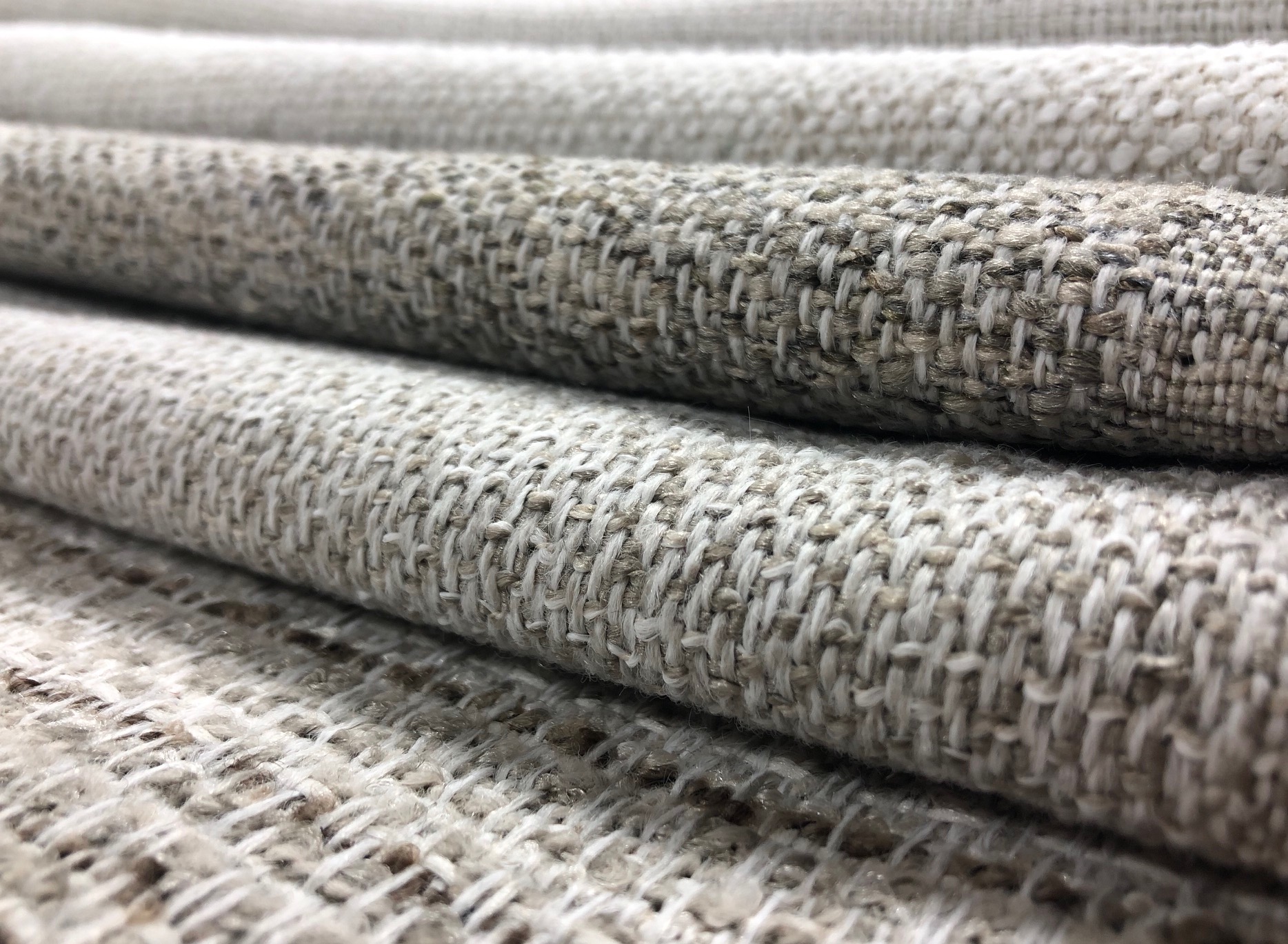
Regarding that organic feel, at Showtime, STI Revolution Performance Fabrics introduced the Artisan Collection with 15 different textures that Marketing Manager Jill Harrill says, “really take the shine out of polypropylene. Revolution is 100 percent polypropylene, also known as olefin, a byproduct of refining petroleum, and it tended to give some of our fabrics a little bit of sheen. So, we came up with a warp system that takes that shine out, and the result is a beautiful, organic cotton-type look that’s super soft. We had a phenomenal response.”
Milliken expanded its Breathe by Milliken line, a fluorine-free fabric collection available in natural or synthetic fibers made from recycled plastic bottles, noting that a sofa covered in Breathe will divert as many as 100 plastic bottles from the landfill. “Milliken has always known that materials matter,” says Milliken & Company Marketing Manager, LeAnne Flack. “People don’t just want to feel good in their spaces, but also about their spaces, and thanks to recent industry efforts, there is no need to compromise. Fabric collections like eco-elegant Breathe by Milliken provide the protection and durability consumers demand in a beautiful and much more sustainable way.”
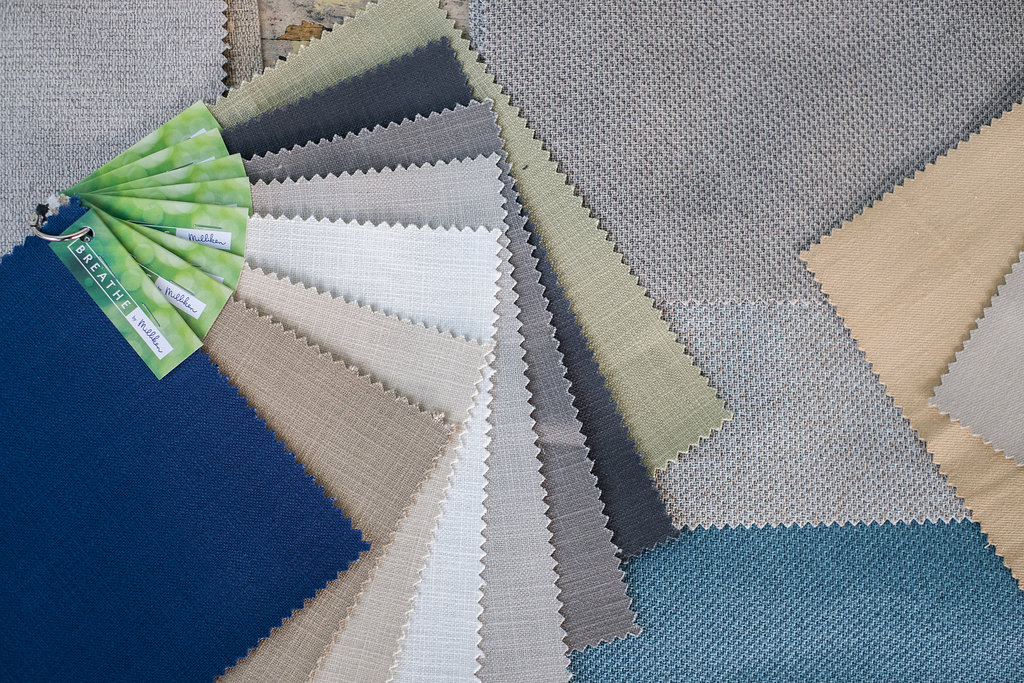
With wellness and sustainability top of mind for many consumers, “the natural option is really an exciting advance in performance fabrics,” McConnell notes, adding that she was really excited to see the debut of Celliant performance fabrics at Keystone Weaving and Se7en Upholstery. Made in the USA, and classified by the Food and Drug Administration as a medical device, Celliant fabrics recycle human energy and are clinically proven to enhance tissue oxygen levels, increasing stamina and improving strength and speed and promoting faster recovery, in addition to endurance and better sleep. “Something like that is more than a performance fabric. It’s actually aiding people, and I think that’s amazing,” she says.
Richloom chose a plant-based clean chemistry for its Fortress performance line for the home. “We’re one of the first major textile companies to move in this direction,” reports Kathleen Maple, Marketing Director, “and we feel very strongly about it. We have put forth the best environmental practices as set forward by the American Chemistry Council, while also meeting the stringent standards of the restricted substances list. We spent the past year trying to figure out where performance is really going and what would set us apart and we believe clean chemistry combined with a great brand name is the answer. The response at Showtime was very, very positive.”
Meanwhile, the news at Inside Out was “performance by the yard,” according to Christy Almond, Vice President of Product Development and Marketing at Valdese Weavers. “We’re offering Inside Out’s favorite basics, which include six styles in 20 colors that are the kind of foundational texture solids you would want in a program, either by the yard or by the roll. It allows customers to add colors they don’t necessarily want to inventory.” Almond says the styles include “a refined tweed, an indoor/outdoor velvet, a natural look that emulates a cotton linen in sun-washed, yarn-dyed colors and a really beautiful, plush chenille. With all the qualities, yarns and colors you would expect in a designer fabric line, you would have no idea they are performance, but they are made to be highly durable, pill resistant, stain and liquid resistant and cleanable with soap and water or bleach. Inside Out is really the first all-in-one performance fabric that allows you to have everything you want in design and color and withstand the elements inside and out.”

Crypton, which launched in Europe for the first time at Heimtextil last month, launched seven new fabric styles at Showtime, with “a great response to the mix of chunky and fine textures of Monk, a wrapped slub bouclé weft with a very fine chenille yarn,” describes Elise Gabrielson, Marketing Director. “We’re influenced by the consumer home trends of chunky texture, handwoven looks and natural fibers. It’s an exciting time for performance fabrics, and there are so many performance stories out there right now. While there are many different brands emerging, the thing that really sets us apart is that performance is all we do and have done for 20-plus years. This is not a trend for us; this is our business.”
“It’s all about innovation now,” says Bill Kimbrell, the former Chief Executive of retailer Star Furniture who now works as a consultant for Crypton. “It’s only rational that a consumer would want a fabric that is stain resistant, odor resistant and resilient.”
Communicating the Message
“We like to think of ourselves as a shortcut in the buying process,” says Harrison Hood, Indoor Sales Manager at Sunbrella, a brand he believes supersedes its category. “People come into a retail store and see Sunbrella on a piece of furniture, and they assume the furniture is Sunbrella. I think we’re one of the only fabric brands in the marketplace that’s afforded that sort of attention, and that brand recognition in the market has helped us grow significantly.”
Sunbrella has been busy as of late co-branding with legacy furniture brands that, like the company itself, have been around for generations. “They’re the experts in furniture and we’re the experts in fabric, and married together, we feel we can bring a compelling product story to retailers, designers and consumers alike.”
At High Point Market last fall, Sunbrella pulled out of its booth space to partner with a handful of manufacturers “we felt had the right differentiation of audiences to cover our bases.” These showroom-within-a-showroom manufacturers included Century, Lee Industries, American Leather and Mitchell Gold + Bob Williams. In American Leather’s case, an entire room in the showroom space was filled with Sunbrella-covered sleeper sofas. The presentation included a “stain bar” with representatives from Sunbrella’s technical services team on hand to walk designers and retailers through the process of cleaning Sunbrella.
In the Century showroom, “we focused more on an elevated aesthetic and did a single vignette in the middle of the showroom with a national ad campaign built around it.” In fact, Sunbrella, which has long been closely associated with outdoor furniture, is launching national co-branded ad campaigns with three of the four brand partners. “For a long time, we’ve been trying to advertise and market the Sunbrella brand to everybody, all at once,” Hood relates. “By partnering with these indoor manufacturers and launching co-branded advertising campaigns, we want to tell a truly indoor story.”
This spring, watch for a new round of manufacturers in High Point to partner with the company. “American Leather, Lee and Century will be featuring us in a significant way again,” Hood says, teasing. “As for the others, I will just say that they’re highly influential brands with the designer community and with specialty retailers.”



